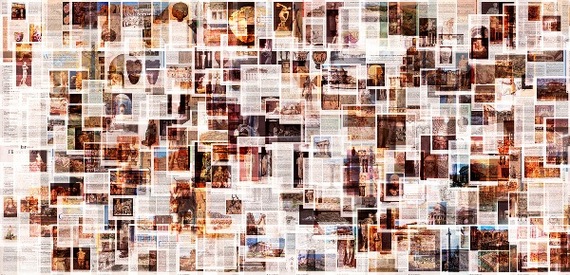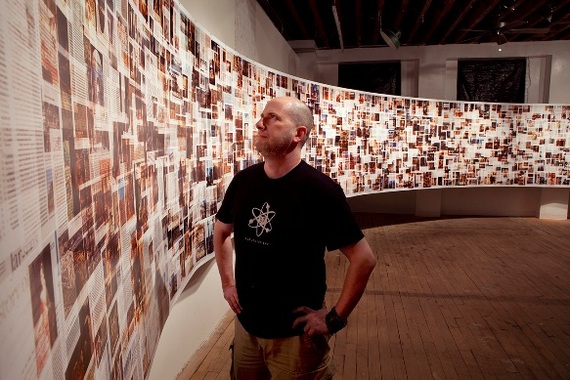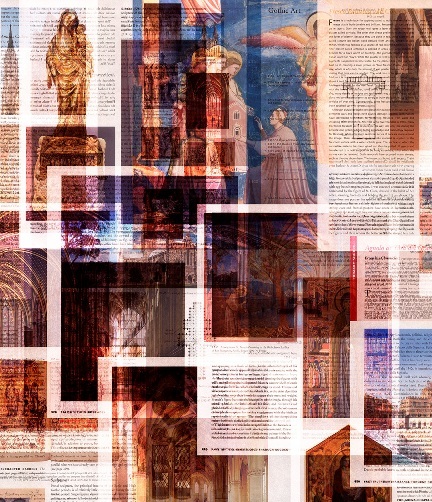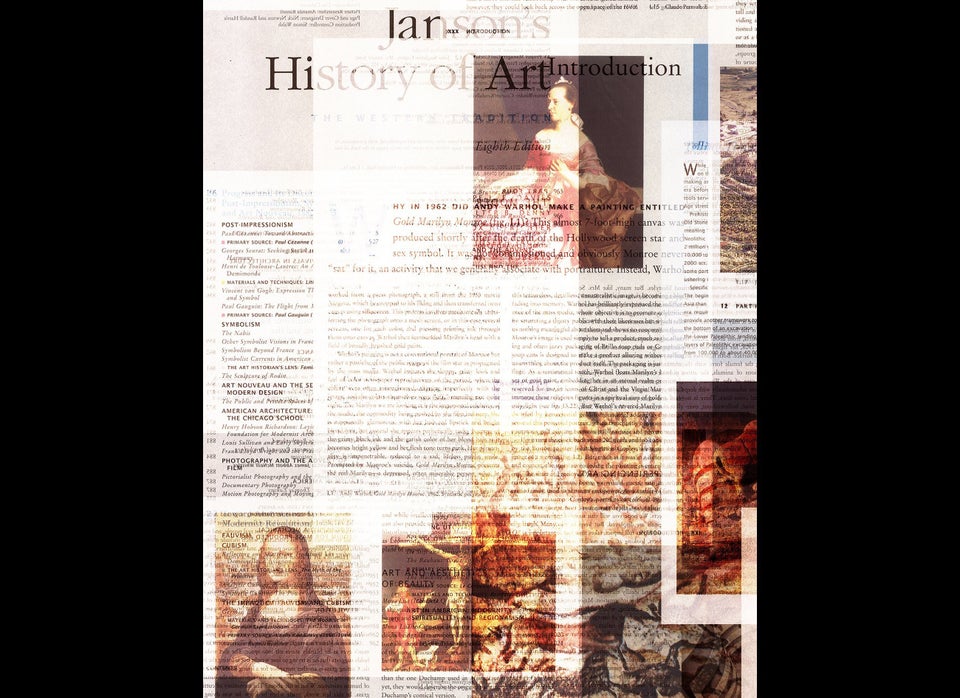 Dean Kessmann, A Layered History of Art: From Semitransparent to Opaque (detail), 2014, archival pigment print, 58" x 480" currently on view at FURTHERMORE LLC in Washington, D.C.
Dean Kessmann, A Layered History of Art: From Semitransparent to Opaque (detail), 2014, archival pigment print, 58" x 480" currently on view at FURTHERMORE LLC in Washington, D.C.
Each page was removed from the binding and scanned by projecting light through it, thus, each page is made to function like a photographic negative, or more accurately, a transparent positive. This engagement with photography corresponds to the recollection and writing of histories. Photography is often uncritically perceived as a medium that produces objective records, yet simultaneously, and perhaps more often, it is a means by which a photographer may produce utterly subjective imagery. Similarly, the written word traverses the continuum from fiction to non-fiction. -- Artist Dean Kessmann
Historians of art attempt to tell the story of our past by studying the cultural remnants left behind. It is usually impossible to recover a complete, irrefutable picture of what happened -- facts and stories lost with the passage of time are difficult to retrieve, requiring painstaking research in archives or slow, careful excavation. Even then, reconstruction happens in bits and pieces. To engage continuously in this endeavor requires something akin to faith. Currently on view at FURTHERMORE in Washington, DC, Dean Kessmann's site-specific installation A Layered History of Art: From Semitransparent to Opaque is a forty-foot long horizontal scroll digitally collaged with pages of that art bible, H.W. Janson's History of Art, and beautifully embodies the faith and hope involved in the imperfect search for truth.
Kessmann's A Layered History measures 58" x 480" and is installed in a monolithic arc that floats across nearly 900 square feet. Scanning each double-sided page literally illuminates them and provides the effect of cathedrals' stained glass windows, reminding me of the interior of Le Corbusier's Notre Dame du Haut (also known as "Ronchamp") (1950-54). Without consciously referencing Le Corbusier's iconic modernist/proto-postmodern masterpiece specifically, Kessmann's monumental work contains many elements that nod to these traditions in Western art. As in Ronchamp, there is a play of tradition versus innovation/technology and representation versus abstraction. And as Ronchamp is a place of pilgrimage and religious faith, in A Layered History we see the culmination of faith shown by countless historians in studying thousands of artworks considered seminal in (Western) cultural history.
Making the work required a leap of faith by not only the artist, but also the exhibition curators/producers José Ruiz and James Huckenpahler at FURTHERMORE. Kessmann started the extremely time-consuming project not knowing what would result from scanning the pages in Janson's 1,000-page textbook and rebuilding them as one image in Photoshop. The artwork in the end became 5 feet tall and 40 feet long, and Huckenpahler and Ruiz of FURTHERMORE worked with Kessmann on the actual production of the archival pigment print, attempting to print the entire work as a continuous, single print. They stated: "Working with Dean was really exciting because we did not know if both the hardware and/or software could print such a large print. Most printshops wouldn't try something like this because of the costs that come up if it doesn't work. You have to start all over. Toss the paper and ink, which are expensive, and start again. We'll venture to say that no printshop in D.C. has attempted this either at work or at home."
In addition, FURTHERMORE worked with Kessmann to come up with a solution for installing and exhibiting the enormous work, and their goal was to find "something monumental that also felt tangible and not overly fabricated." FURTHERMORE's philosophy of fostering experimentation and collaboration resulted in resourcefully calling in Dan McCauley and Richard Vosseller of Sculptural Constructs, artists specializing in creative solutions to artistic, material and engineering problems. McCauley and Vosseller helped design and build a curved wall/mount which is not seen by the viewer but supports the print. FURTHERMORE described: "We gave them a budget, and their solution was to use similar techniques used in making skateboard ramps to make a perfect, seamless arc that was light enough to appear as though it was floating in the air. And then there was lift-off..."

James Huckenpahler views Dean Kessmann's A Layered History: From Semitransparent to Opaque installation at FURTHERMORE, the multi-platform arts space he and José Ruiz direct in Washington, DC
This work is the latest in Kessmann's exploration of re-examining ever-present phenomena and ephemera in our everyday lives. Trained in photography, Kessmann creates the effects of a zoom or multiple lenses and different types of lighting on these subjects, which range from the hidden folded corners of food packaging like cereal boxes to pages of the Bible. In these projects, Kessmann attempts to reveal what lies beyond the apparent to us, beneath the surface and between the lines. A Layered History's collaging of the double-sided pages of Janson's textbook suggest the presence of different perspectives (including perhaps some not presented) as well as the veils created by looking from any perspective. Indeed one of the impressions A Layered History gives is that Janson's History of Art in its totality (despite its authoritative title and its approximately 1,000 pages) still has some missing pieces to the "puzzle" of art history. As many comment, Janson and many art historians have neglected the cultural contributions of women, people of color and outliers.
At the same time, most American lovers of art cannot deny the influence of Janson on them. I, for one, as an undergraduate at a college famous at one time for that "Williams art mafia," it was nearly a rite of passage to enroll in ARTH101-102 and figure out how to carry home the gigantic tome along with other textbooks purchased at the college bookstore that day. In Kessmann's A Layered History, we can see traces and figments of the Giotto, Parthenon, Michaelangelo and Pollock that many of us first studied in school. As Kessmann states: "While the narrative presented in Janson's History of Art will always be imperfect and incomplete...it has introduced many students to the discipline in which I am a part. In fact, I read this textbook as an undergraduate student. While I cannot recall the exact moment, this book most likely, at least in part, contributed to my decision to become an artist. In this respect, it is a celebration of this text."
Check out more images and details in the slideshow. All images courtesy of the artist and FURTHERMORE LLC, unless otherwise noted. Dean Kessmann's A Layered History: From Semitransparent to Opaque is on view until June 14, 2014 (extended date) at FURTHERMORE (T: 202.330.1219; http://www.furthermorellc.com/contact.cfm) in Washington, DC.

